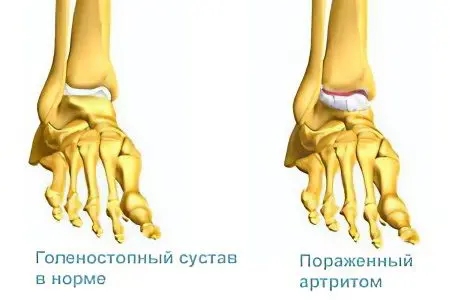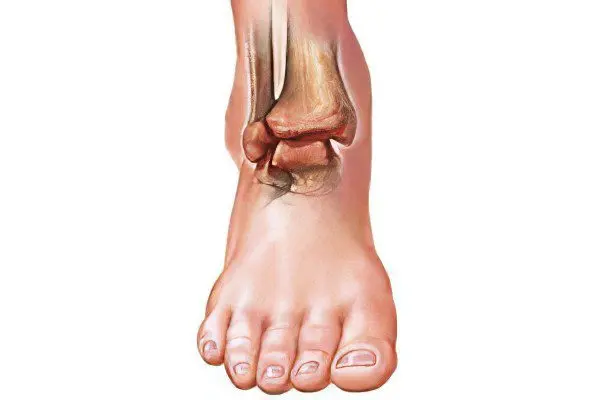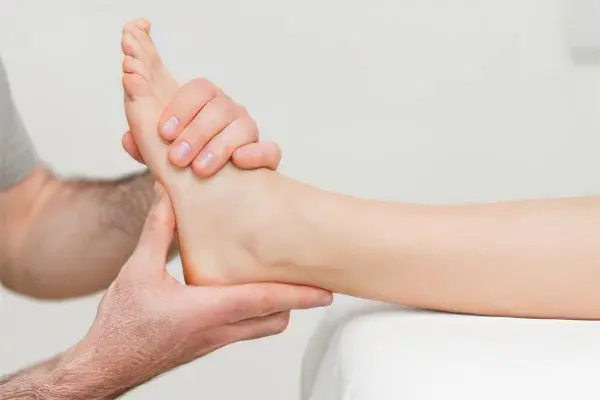Contents
What is ankle arthritis?
Ankle arthritis is an inflammation of the ankle joint that develops against the background of systemic lupus, gout, Bechterew’s disease, rheumatoid arthritis. The course of the pathological process is often accompanied by an infection that enters the damaged joint through the blood and lymph.
The name of the ankle joint speaks for itself, it connects the foot and lower leg. Due to the complex structure and the special shape of the joint, the human feet have high mobility. Moreover, if we compare the daily load on the knee, hip and ankle joint, then the latter is much higher, which means that it is more prone to injury or other damage.
Symptoms of ankle arthritis

Ankle arthritis has two forms: acute and chronic:
The acute form is characterized by a rapid onset of the disease with vivid symptoms, which is expressed in the rapid development of edema in the joint area with an increase in local temperature. In acute purulent form, the skin over the affected joint acquires a reddish tint. Body temperature is high.
Ankle arthritis in a chronic form manifests itself as a feeling of stiffness in the joint and pain. These signs are especially pronounced when a person wakes up after a night’s sleep, at this moment, redness and swelling are almost not observed.
The manifestation of general symptoms of the disease depends on the form of the pathological process. It is important to understand that the lack of adequate treatment for two years threatens to completely destroy the cartilage of the ankle joint. As a result, the area of the joint noticeably thickens, while its position becomes unnatural, the person experiences significant difficulties in walking, and passive movements of the ankle become extremely difficult or even impossible. Atrophy of the leg muscles speaks of the severe neglect of the disease – one leg becomes much thinner than the other.
According to the symptoms of ankle arthritis, one can judge the underlying pathology that caused the development of this disease.
But since this is an inflammatory process, the following signs are inherent in it:
pain in one joint or both at once;
puffiness, which is characterized by a slow smoothing of the fossa formed after pressing it with a finger;
redness of the skin, accompanied by an increase in local temperature (the ankle area “burns”);
limited mobility of the affected joint and difficulty in moving;
weakness, deterioration of health, body temperature is increased.
The main symptom of arthritis is difficulty moving, which cannot be ignored. It is for this reason that people go to the doctor for the first appointment.
The initial stage of the disease can manifest itself in an acute form, or proceed gradually.
The disease does not manifest itself in any way in the earliest stages, but the following symptoms indicate the onset of the inflammatory process:
habitual shoes become tight, which indicates the presence of edema;
flexion and extension of the ankle is accompanied by painful sensations.
Let’s focus on the next generation. The symptomatology of “children’s” ankle arthritis is identical to the “adult”. It is difficult for children to explain the feeling of discomfort, they can describe their condition simply: “My leg hurts” and refuse to move on their own. These complaints cannot be ignored, you need to examine the ankle and, if there are the slightest manifestations of edema, show the child to the doctor. Injuries to the ankle joint at an early age can lead to the development of serious diseases in adulthood.
Causes of Arthritis of the Ankle

Arthritis of the ankle joint is divided into types. Consider each and understand the reasons for its development:
Rheumatoid arthritis. It is considered a systemic disease localized in the ankle area. An important role in the development of this disease is played by the genetic predisposition of a person. Its course is often accompanied by mild swelling and aching pain in the joint.
Periarthritis. This variety is characterized by inflammation of the tissues surrounding the surface of the joint. Degenerative processes rarely affect the ankle, but this disease is characterized by pain and limited motor activity of the joint.
Traumatic arthritis. Its very name speaks of the cause of its occurrence – it is sprain or rupture of the articular ligaments, bruises and other closed injuries. As a result of damage, a certain amount of blood enters the joint cavity, which causes aseptic inflammation. With an open injury (gunshot wounds), septic (purulent) arthritis almost always develops.
Gouty arthritis. The reason for the development of the disease is a metabolic disorder (metabolism) caused by bad habits (abuse of tobacco, coffee, alcohol). These excesses increase the level of uric acid in the human blood, with the withdrawal of which the body can no longer cope. As a result, its salts (urates) are deposited in tissues and organs.
reactive arthritis. It affects the joints as a result of transferred nasopharyngeal, genitourinary, intestinal infections. Accompanied by pain in the ankle joint, slight swelling and stiffness of movements.
Post-traumatic arthritis. The cause of the disease is mechanical damage to the cartilage, capsule, tendons, ligaments of the joint. This problem is often addressed by hockey players and football players, fans of skis or skates, lovers of shoes with high and unstable heels.
Common causes of ankle arthritis are::
infectious attack of the joint by pathogenic bacteria. There is a specific form of the disease (infection with a pale spirochete, chlamydia or gonococcus) and a non-specific form – a secondary response to furunculosis or influenza;
metabolic disorder (gout) caused by the presence of parasitic invasion, bad habits. Arthritis, in this case, is considered as a secondary disease;
failure in the immune system (Bekhterev’s disease, systemic lupus erythematosus). The body perceives the tissues of the joint as foreign and begins direct aggression against them;
mechanical damage and trauma to the joint.
The causes of ankle arthritis may be intestinal or urogenital infections (urethritis, acute prostatitis, enterocolitis, vaginitis). They can cause reactive arthritis days or weeks after the onset of the underlying disease.
Ankle arthritis can be caused by:
overweight,
sharp hypothermia,
hormonal failure,
metabolic disorder,
wearing tight shoes or walking in unstable high heels,
flat footed,
hereditary predisposition,
professional activities (mobile sports, ballet),
bad habits,
low immunity, allergies.
Treatment of ankle arthritis

After the doctor has made a final diagnosis indicating signs of ankle arthritis, the patient is first assigned maximum rest. If possible, bed rest. If complete rest cannot be observed, then immobilization with elastic bandages is necessary. Crutches or a cane, orthopedic shoes or inserts should be used as aids.
Depending on the form of the disease, treatment can be conservative or surgical.
Conservative treatment is reduced to:
antibiotic therapy, the appointment of which is justified only in the fight against the bacterial form of the disease. Antibacterial drugs with a wide spectrum of action are used (tetracycline, chloramphenicol);
a special diet in which the patient should give up nightshade, as they provoke pain, and from the use of canned and smoked meats, since they contain a large amount of salt;
anti-inflammatory nonsteroidal drugs such as diclofenac, aspirin, voltaren. They reduce swelling, but their use should be under the supervision of a specialist, as they have undesirable side effects. When the disease is in the progression stage, hormone therapy is prescribed;
painkillers. These funds are necessary for the patient to relieve pain in the affected area. However, when the pain stops, the person feels relieved and begins to increase the load on the ankle, which is fraught with even more problems with the joint. That is why doctors categorically insist on the use of crutches and other aids during the treatment period;
vitamin therapy. To improve metabolic processes in the body as a whole and directly in the damaged joint, folic acid and vitamins B and C are prescribed;
biologically active supplements with collagen as the main component. It contains glucosamine, which acts as an anti-inflammatory agent, and collagen hydrolyzate, a component that is part of the structure of the cartilage tissue of the joint.
With untimely treatment of the disease, synovitis or deforming arthrosis may develop, and then drug therapy is no longer enough.
As for surgical treatment, it can be prescribed only in case of severe and advanced forms of the disease that caused the deformity of the ankle joint. The purpose of the intervention is to increase the ability of the joint to move. The main methods are reduced to fusion or prosthetics of the ankle joint.
In the treatment of ankle arthritis, physiotherapeutic methods are actively used, such as ultrasound, hydromassage. With their help, you can significantly reduce pain, and in addition, they help restore the function of the affected joint.
Physicians recommend physical therapy as a therapeutic and rehabilitation measure. These exercises help strengthen the muscles surrounding the ankle joint, which relieves stress on the ankle.
If the usual walk is still difficult, then it can be replaced by visits to the pool. Movement in the water will ease the load on the ankle.
A visit to a sanatorium will contribute to the fastest recovery after suffering arthritis of the ankle joint. With the help of mud therapy sessions, hydromassage, deep warming and therapeutic baths, patients manage to get rid of the consequences of the disease or delay the next exacerbation, if we are talking about a chronic form of ankle arthritis.









